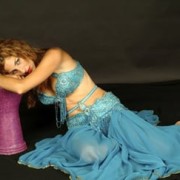Michele Tayoun
Michele has performed and taught Middle Eastern dance throughout the region for the past 17 years in schools, day camps, concert halls and community centers. She has recently started exploring Arabic vocals as well. The emotional and aesthetic power of Arabic music and dance, from the oud, nay, Arabic violin, and tabla to the debke (traditional folk dances) and raqs sharqee (popularly known as belly dance) has influenced her sense of creativity, beauty and love. Michele’s art grows out of her musical Lebanese-American family and the Lebanese community in South Philadelphia in which she grew up. Her entire life as an artist, she has been proud of her art and artistic heritage, while also carrying the burden of stereotypes about Middle Eastern women in particular. Her art includes educational components to help encourage people to view women performers differently and to provide a contrast to the mainstream media that puts forth negative images that reduce centuries of splendid and complex cultures into stereotypes. Her work is that of breaking down barriers, helping people see how cultures, traditions and artistic practices influence and complement each other. This is illustrated in her work with the ensemble, Herencia Arabe (meaning Arab heritage in Spanish), a collaboration between flamenco and Arabic musicians and dancers. This group was created to show the shared roots between these two traditions.
Awarded Grants
2005
Leeway Transformation Award (LTA)
Overview
Michele has performed and taught Middle Eastern dance throughout the region for the past 17 years in schools, day camps, concert halls and community centers. She has recently started exploring Arabic vocals as well. The emotional and aesthetic power of Arabic music and dance, from the oud, nay, Arabic violin, and tabla to the debke (traditional folk dances) and raqs sharqee (popularly known as belly dance) has influenced her sense of creativity, beauty and love. Michele’s art grows out of her musical Lebanese-American family and the Lebanese community in South Philadelphia in which she grew up. Her entire life as an artist, she has been proud of her art and artistic heritage, while also carrying the burden of stereotypes about Middle Eastern women in particular. Her art includes educational components to help encourage people to view women performers differently and to provide a contrast to the mainstream media that puts forth negative images that reduce centuries of splendid and complex cultures into stereotypes. Her work is that of breaking down barriers, helping people see how cultures, traditions and artistic practices influence and complement each other. This is illustrated in her work with the ensemble, Herencia Arabe (meaning Arab heritage in Spanish), a collaboration between flamenco and Arabic musicians and dancers. This group was created to show the shared roots between these two traditions.



